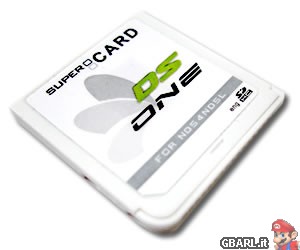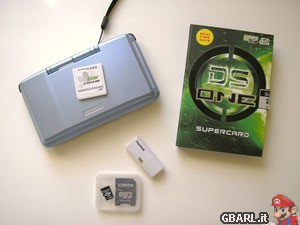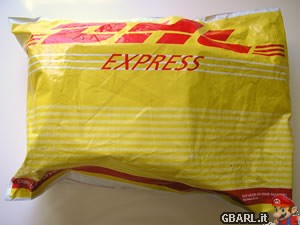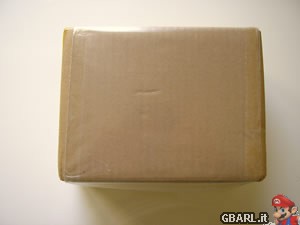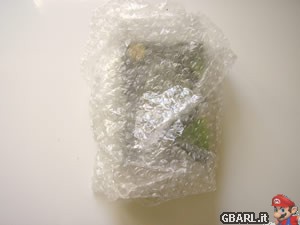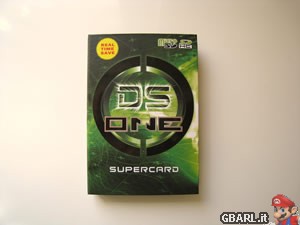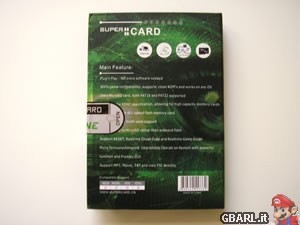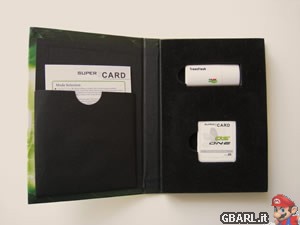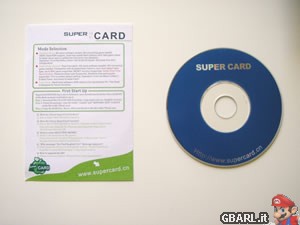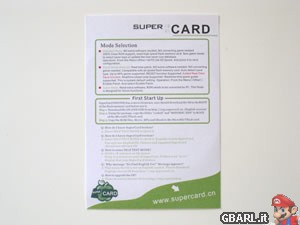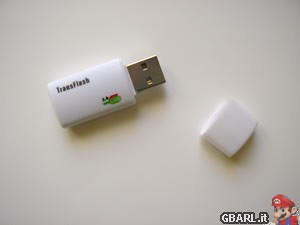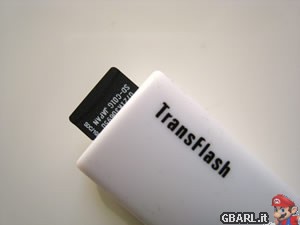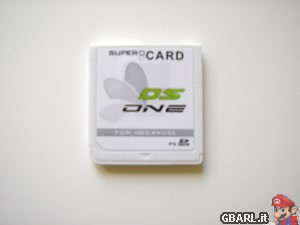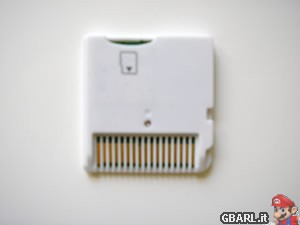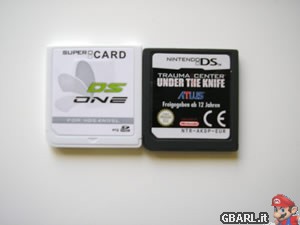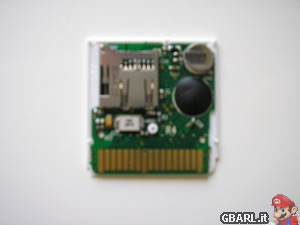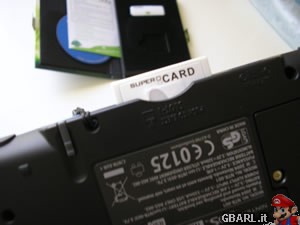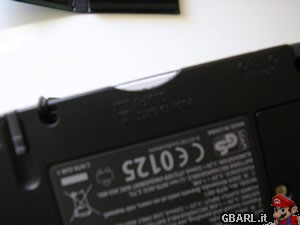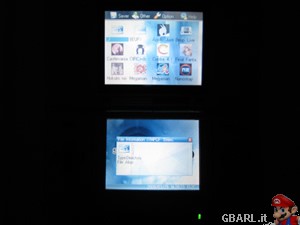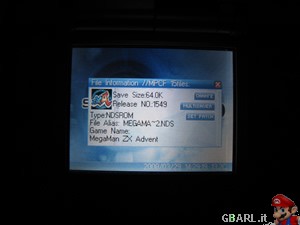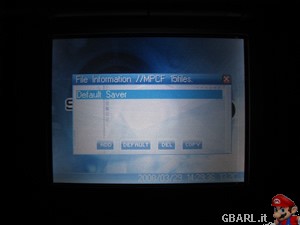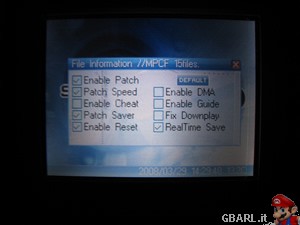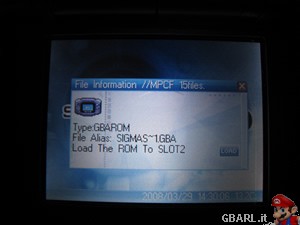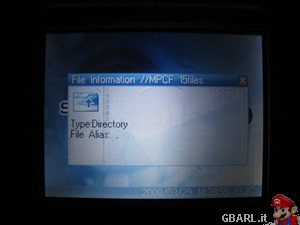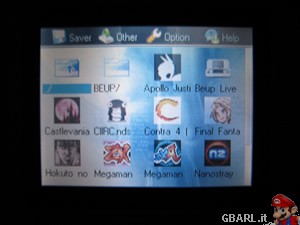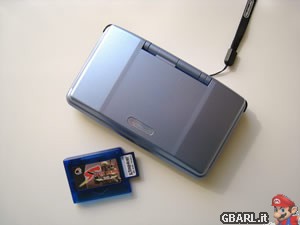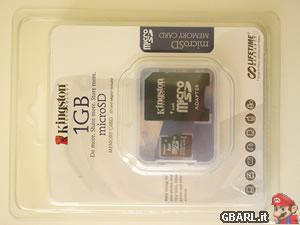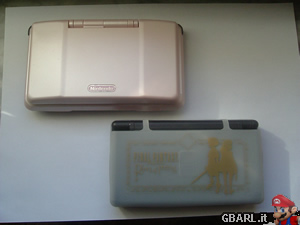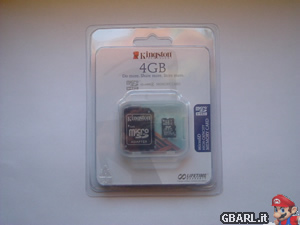Benvenuto Visitatore ( Log In | Registrati )
  |
 Friday 22 February 2008 - 14:04 Friday 22 February 2008 - 14:04
Messaggio
#1
|
|
 The Evra Powwah! (Pirla) Gruppo: Veterani Messaggi: 10.824 Iscritto il: Fri 24 December 2004 - 19:38 Da: Nosgoth Utente Nr.: 3.467 Feedback: 0 (0%) |
Quick Links Homepage: http://eng.supercard.cn/ Updates: GbaRL.it Download Area Our thanks to Supercard Team and RomMan for the sample provided. Supercard: unless you're a complete newcomer in GBA/DS hacking, this name won't be unknown to you. This brand encompasses a wide range of successful and largely popular products going way back, to when touch screens were something you'd find on Star Trek and the GameBoy Advance was all the rage: that large, bulky blue cartridge with a taste for SD cards was, for many (and for myself), the first step into this side of the gaming world. Their winning streak isn't over, either: after a slow start, due to a system software with a fair amount of rough edges, the Supercard DS ONE Slot-1 kit affirmed itself as one of the most reliable, well-supported and feature packed flashcards on the market. The sale figures were more than enough for the team to just sit back and relax, yet over the last year there was a steady trickle of firmware updates, each of them improving performance or adding a new function; now, our site is proud to review the latest update of this already appreciated hardware, the Supercard DS ONE SDHC, which we'll commonly refer to as a 'Mk. II'. Introduction & Features Ease of use, excellent build, constant support: these three traits have always been Supercards' distinguishing features. That was true for the (relatively) old SD-and-CF-powered GBA flashes, and it still holds true for this new DS ONE: everything you need is in the cart, be it homebrew patching, advanced gaming options or music playback; a microSD is the only real requirement. Given how the team has always set the bar quite high, we expect nothing short of excellence from this hardware. As we briefly mentioned above, this is not a completely new design, but rather an upgraded version of the widely spread non-SDHC DS ONE, up to the point that system updates are shared between said models. As usual, let's open our review with a quick look at the feature list, as provided by the manufacturer:
Knowing the SC Team, though, we wouldn't define this list as "final": given certain design choices, we wouldn't be surprised if more features were added or expanded upon - real time save was announced completely out of the blue, after all - so is with these subtle promises in mind that we proceed with testing this unit. -------------------- Just keep tryin'
Keep on flyin' I will be the light... - from Last Exile: Cloud Age Symphony - Togisumasareta tsume wo hate ima kagayaku tame ni sono kiba wo muke... Shiren wa norikoerarenai hito ni osoikakari wa shinai! - from Megaman X8: Wild Fang - Proud supporter of EVAC Industry co.ltd. |
|
|
|
 Sunday 24 February 2008 - 19:50 Sunday 24 February 2008 - 19:50
Messaggio
#2
|
|
 The Evra Powwah! (Pirla) Gruppo: Veterani Messaggi: 10.824 Iscritto il: Fri 24 December 2004 - 19:38 Da: Nosgoth Utente Nr.: 3.467 Feedback: 0 (0%) |
It's with a slight sense of dčją-vu that we approach our workbench, if only for how many times we were faced with the yellow and red color scheme typical of DHL: the sample sent to us was the latest rolling out of the assembly line, although in late February 2008 the circuit board has been updated with minor changes, which we'll take into account later. This time, we received quite a sizeable package: once cutting open the outer envelope, we were presented with a sturdy cardboard box. The third image shows what's inside: our flashcard, nested within two rounds of bubblewrap. To say the DS ONE was well-protected would be a serious understatement: praises to the team for the care they took into packaging it, to the point we had to resort to something sharper that our standard pair of scissors to open up the box. Anyway, back to our Supercard DS ONE, with a look at the package, pictured below. Resembling a book, the DS ONE Mk. II box is identical to the one housing the previous, non-HC version of the card, although with a different color scheme and the latest features included. 'Matrix green' is the predominant tint, something we're accustomed with ever since that movie's release. On the front, not much has changed from the previous DS ONE: the card's logo takes nearly the entire space, along with the Supercard brand directly beneath and the 'i]microSD compatible[/i]' symbol in the top right corner; said markings are all embossed, which gives a pleasant additional touch to the overall finish of the box. Notable additions are the SDHC logo and a small, yellow mark which advertises one of the card's most notable features: real-time save. Once turned, we're presented with the usual full listing of the card's features, updated to include the latest additions from the SC Team, such as multi-saver and Supercard's own Blue Light Engine for optimal performance on a wide range of microSD I/O speeds; a barcode and the standard hardware compatibility breakdown are directly beneath. A touch of nostalgy: the four icons before the features list are the latest evolution of the "instruction manual" found on older Supercards, that being a set of pictures explaining in brief how to use the flashcard. The DS ONE package is factory-sealed by an adhesive strip, which doubles as both a warranty seal and a mean to keep the box closed: once carefully peeled off - it comes loose pretty easily, but we wouldn't advice you to simply rip it off to avoid causing damage - the contents are accessible. Luxurious: this is the first word that comes to our minds while detailing the innards of the package: on the left, a small pouch holds a one-sheet instructions manual and a somewhat more concealed miniCD with an older revision of the Supercard ONE OS (which will be further detailed in a while), while the entire right part is a large, black piece of foam which houses the DS ONE itself and a small microSD/HC reader. So far, this has been by all means one of the best card packagings we've seen: even without being made of tin, like those round G6 cans, the DS ONE box is well-built and finely printed (admittedly, we don't consider Engrish to be a problem), really shining once the user opens it. The card and card reader are well protected and everything is carefully arranged for ease of access, which is always a plus considering how such hardware is aimed not only at hackers and power users, but also at newcomers. Let's now take a closer look at the content, starting with the instructions manual and driver disc. Admittedly, more than a manual this small sheet of paper is more of a quick reference card, printed in both Chinese and English (one language per side), yet it proves useful for detailing basic operation of the hardware and an outline of its most advanced features, such as the three modes we'll describe in the relevant section of the review. We appreciated how crucial features such as the self-test mode were mentioned, along with common troubleshooting and firmware update questions; as complete as PDF manuals can be, printed instructions always prove invaluable for hardware as "uncommon" as flashcards. The only downside is the incredibly small font used: we were unsure whether to use a magnifier or not to read more clearly. Now, for the driver disc: interestingly enough, it contains not only the OS for the DS ONE, but also for all other Supercard products, proving useful for those users owning them and wishing to take full advantage of the already mentioned interaction between them and the DS ONE. Neverthless we'd advice downloading the latest version from the official site, seeing how the revision included is an old v3.0 released on December 2007. The Supercard DS ONE comes bundled with a compact microSD USB 2.0 reader, HC compatible. It features a simple yet elegant design, with a white plastic case and removable cap protecting the USB connector: the card slot is on top of the unit, where a small notch for attaching it to a keychain or necklare can also be found. When connected, it's automatically recognised by all major OS'es (we've tested Windows Vista and Ubuntu Linux) and a red LED lights up within the unit. Our complain for an otherwise excellent and stylish reader is how unprotected the microSD is: almost like the old Supercard CF, the card is only halfway inserted, hence prone to break should one accidentally hit it; on top of it, it broke down after roughly two weeks. Now, let's examine the flashcard itself: the DS ONE Mk.II is a Slot-1 flashcard, identical in size and shape to a standard, Nintendo produced cartridge, differing from its non-HC counterpart by its white shell and new sticker graphics, which covers the entire front. Once turned around, you will notice the drawing detailing the correct orientation for memory card insertion, as well as a tiny screw: the latter's role will be explained later. The microSD slot is spring-loaded: whether this is a pro or con it's somewhat of a matter of personal taste and build quality of the hardware; some manufacturers opted for springs, other did otherwise. As disastrous as it was the the older R4 revisions, we do prefer this kind of mechanism, as it allows for easier removal of the card, which would otherwise require one's fingernails. While the card will not stick from the top of the DS ONE (actually stopping half a millimeter short of it), the usual drawback of requiring a small fingertip or nails to apply pressure on it is unavoidable: the spring itself poses quite a bit of resistance against the microSD, something we assume is due to either the flashcard being brand new or the component's quality being remarkable. We mentioned a small screw on the back of the card: while other manufacturers chose either to keep the two halves of the shell joined by plastic clasps or by old plain glue (the latter something we are thoroughly annoyed with, to tell the truth), unscrewing it will grant easy access to the circuit board, as shown above. We didn't completely remove it from its casing as the components (namely the PSRAM module) on the back actually stick out from a hole in the shell and adhere to the sticker, but that's something that does not hinder the user when operating on the board. Owners of the older model will notice how the circuitry is now green, as opposed to red, although this is just a cosmetic change; we mentioned how, as of February 2008, the manufacturer seems to have updated the card's design: apparently, the only modifications were a relocation of the controller chip (hidden under a large drop of black epoxy in the pictures above) and the battery (whose function is unclear) moved in its place. This change is understandable if you think of one the DS ONE's greatest weaknesses: PSRAM. The entire Supercard series, ever since its first specimens, always used this component, whose failure almost invariably cripples the hardware. Lately, a noticeable batch of units turned out to be either faulty or extremely fragile in this regard, which explains the team's prompt redesign. Overall, this DS ONE Mk.II proves to be a well-built unit: the plastic shell is solid and safely kept closed by plastic pins and a single screw, something which ensures protection against accidents while allowing power users to take a peek inside; what did not convince us, though, was the choice (shared with other products such as the DS-Link, first-generation DSTT and EDGE DS) to keep the PSRAM vulnerable, covered only by the sticker. Seeing how another sensitive component -the internal battery- was moved to a safer place and how said memory chip is at the root of a common hardware fault trying to squeeze it inside the casing would've been wiser. -------------------- Just keep tryin'
Keep on flyin' I will be the light... - from Last Exile: Cloud Age Symphony - Togisumasareta tsume wo hate ima kagayaku tame ni sono kiba wo muke... Shiren wa norikoerarenai hito ni osoikakari wa shinai! - from Megaman X8: Wild Fang - Proud supporter of EVAC Industry co.ltd. |
|
|
|
 Wednesday 27 February 2008 - 14:01 Wednesday 27 February 2008 - 14:01
Messaggio
#3
|
|
 The Evra Powwah! (Pirla) Gruppo: Veterani Messaggi: 10.824 Iscritto il: Fri 24 December 2004 - 19:38 Da: Nosgoth Utente Nr.: 3.467 Feedback: 0 (0%) |
Getting Started The DS ONE setup is extremely simple: as with most other Slot-1 flashcards it's only a matter of downloading the latest system update and copying it to the microSD card, inserting it into the card and plugging everything into your Nintendo DS. As difficult as it is to bid farewell to our trusty Supercard patching software, it is not necessary anymore. The archive, no matter whether it's the one in the included mini-CD or a copy pulled off Supercard's website, always includes an offline version of the online user manual, a valuable extra (Linux users, beware: you'll need kchmpart or its Gnome equivalent to open it). The entire procedure is extremely simple, with nothing extraordinary to point out: here is how the card appears once everything is in place. -------------------- Just keep tryin'
Keep on flyin' I will be the light... - from Last Exile: Cloud Age Symphony - Togisumasareta tsume wo hate ima kagayaku tame ni sono kiba wo muke... Shiren wa norikoerarenai hito ni osoikakari wa shinai! - from Megaman X8: Wild Fang - Proud supporter of EVAC Industry co.ltd. |
|
|
|
 Saturday 1 March 2008 - 13:07 Saturday 1 March 2008 - 13:07
Messaggio
#4
|
|
 The Evra Powwah! (Pirla) Gruppo: Veterani Messaggi: 10.824 Iscritto il: Fri 24 December 2004 - 19:38 Da: Nosgoth Utente Nr.: 3.467 Feedback: 0 (0%) |
GUI & System Software Let's now switch on our DS and take a look at the card in action: as soon as you'll reach the much loved/hated health & safety disclaimer, the DS ONE's Passcard mode will immediately kick in, redirecting you to the card's OS. This seems to be a trend with newer flashcards, although some users prefer being still able to access the DS dashboard without removing the card first. The DS ONE system software is nothing more than a heavily modified and graphically customized Moonshell: the advantage of such a choice is being able to effortlessly offer advanced features such as music and movie playback out of the box and with little source code modification, although a few design choices are slightly debatable, as we'll explain. One thing to remember, though, is that the top and bottom screens can be flipped by pressing L+A. Let's start from the lower screen, whose prominent use is for single ROM management and multimedia features, as well as additional windows such as the online help. The only window visible on startup, and the most useful by far, is the Information Window: according to the file selected, advanced features and specific options (like multisavers) will be accessible. As customary, the game icon is displayed, along with pleasantries such as its size, release number, saver size and so on. Keep in mind, though, that said info are retrieved from an internal database updated with every OS release: homebrews and newer games will display a substantially reduced amount of details. Also, three additional buttons are shown, which we'll take into account right now. CHANGE: one of the advantages of an internal ROM database is saver size autodetection. Nevertless, should the need arise, the save size can be changed with this option, which covers all EEPROM sizes used so far by Nintendo. MULTISAVER: another unique feature of the DS ONE is support for multiple savefiles. Most DS games offer the player three slots for three different savegames, yet some (like Assassin's Creed DS) lack such an option. The multisaver screen allows for creation and management of different .sav files, even including an option for selecting one of them as default. Somewhat useless for those jealous of their console, undoubtedly invaluable for dealing with those pesky siblings. SET PATCH: a trademark of Supercard products, this menu lists all options for the selected game. It is perhaps the most obscure of them all, being only partially documented. Let's take a closer look:
The lower margin of the screen is taken by Moonshell's trademark digital clock and termometer, which is as inaccurate as we've come to expect from it. The top screen displays the file browser, which comes in three flavors (a plaintext list and a more graphical one with three icon size settings), along with three option menus and the Online Help, whose icons are aligned along the top margin. This is where a peculiarity of the DS ONE's design comes to the forefront: button shortcuts. Frankly, there are just too many combinations, some of the utmost importance, some not, and the aforementioned Online Help details only a small fraction of them - shortcuts for activating pleasantries such as RTS, soft reset and the like can be learned only via the manual included in the CD. For example, accessing the menu on the top screen would require holding the R shoulder button and using the D-Pad, yet it's more practical to just press L+A to swap the screens, thus enabling touchscreen operation. This, along with a not exactly flawless input detection, is an obvious giveaway of the system software's roots. In any case, let's now detail the various submenus Saver: sets the default size for save files. Keep in mind that the DS ONE has no onboard EEPROM for hardware saves, and therefore every time you save your game, the microSD itself is used for that purpose. Other: this is where most game-centric functions are filed. The eight available options are:
Help: the standard help window from Moonshell, with a few DS ONE specific commands detailed. While the choice of adapting Moonshell to serve as the DS ONE's system software brings a few, fundamental advantages (such as media playback and text reading straight out of the box), many design choices negatively impact the card's ease-of-use. Most notably, the amount of submenus - and button shortcuts - presented to the user: indeed, the countless and unique functions offered by this flashcard call for an equally complex OS, but this is just too complex. This is due, in no small part, to how the card itself has been designed, that is by taking the older Slot-2 premises and translating them into a Slot-1 environment. While most flashcards nowadays avoid messing with the ROM's code, along with autodetecting basic parameters such as memory I/O speed and saver size, the DS ONE takes a different approach, where the game code is modified for even the basic premise of saver storage (again, this cart has no internal EEPROM, relying on direct memory accesses) and microSD compatibility. But again, if this is mandatory, why giving the user an option to disable basic patches entirely? Why not displaying only switches for advanced functions, such as RTS, cheats and multisavers? Also, more than half of the commands/shortcuts are documented in the CD manual only, and not in Moonshell's Help dialog: while a power user won't be troubled by this, a newcomer will (metaphorically) drown in the card's functions and menus. In the end, as much as we enjoy this Moonshell-turned-OS, a little streamlining and fine-tuning wouldn't hurt. -------------------- Just keep tryin'
Keep on flyin' I will be the light... - from Last Exile: Cloud Age Symphony - Togisumasareta tsume wo hate ima kagayaku tame ni sono kiba wo muke... Shiren wa norikoerarenai hito ni osoikakari wa shinai! - from Megaman X8: Wild Fang - Proud supporter of EVAC Industry co.ltd. |
|
|
|
 Monday 17 March 2008 - 13:28 Monday 17 March 2008 - 13:28
Messaggio
#5
|
|
 The Evra Powwah! (Pirla) Gruppo: Veterani Messaggi: 10.824 Iscritto il: Fri 24 December 2004 - 19:38 Da: Nosgoth Utente Nr.: 3.467 Feedback: 0 (0%) |
Compatibility and Performance After taking care of the descriptive part, we can field test our DS ONE Mk.II. Given the card's unique features, we altered our standard testing protocol to give a full overview of all its specs. In order to perform our tests, we used a retail DS ONE Mk.II for comparison, along with an older Supercard SD (Slot-2) and two microSD's, HC and non-HC. Here is the customary detailed breakdown:
The software revision used is version 3.0 SP2, the latest available as of March 2008, with default options (Enable Patch, Enable Reset, Patch SD Card Speed, Saver Patch). Homebrew Homebrewing on the DS ONE is as simple as it can become: just copy the relevant files over and you're ready to go. DLDI auto-patching has become a common feature among recent flashcards and has significantly reduced the hassle for less experienced users. Also, the need of a specifically compiled executable, as was the case with Slot-2 Supercard units, is no more: we tested ScummVM DS, DSOrganize, ClIRC and Beup Live without encountering a single glitch. DS Games And now, DS games. What follows is the complete list of the titles we tested, their color showing their compatibility.
CSI: Dark Motives Real Football 2008 Warhammer 40k: Squad Command Drawn to Life Mario Party DS Megaman Star Force: Dragon Pro Evolution Soccer 2008 Contra 4 Advance Wars: Days of Ruin Pokčmon Diamond Sonic Rush Adventure The Legend of Spyro: A New Beginning Asterix & Obelix at the Olympic Games New Zealand Story New Super Mario Bros Yu-GiOh! World Championship 2007 Zoo Keeper Bubble Bobble: Double Shot Another Code: Two Memories Nanostray Electroplankton Pac'n Roll Lost in Blue Kirby Canvas Course Battles of Prince of Persia Burnout Legends Mario & Luigi: Partners in Time Fifa Street 2 James Pond Puyo Pop Fever Bomberman DS Osu! Tatakae! Ouendan! Megaman ZX Megaman ZX Advent Star Trek Tactical Assault Cooking Mama Yoshi's Island DS Zendoku Ratatouille 42 All-time Classics Animal Crossing Bee Movie Brain Training More Brain Training Crash Bandicoot Titans Ferrari Challenge Imagine Baby-sitter Giulia Passione Stilista Left or Right Luxor: Pharaoh's Challenge Mario & Sonic at the Olympic Games Mario Kart DS Metroid Prime Hunters Ultimate Mortal Kombat DS Mistery Detective Shrek the Third Lunar Knights Picross DS Orcs & Elves Tetris DS The Legend of Zelda: Phantom Hourglass GBA Games As we've pointed out on a few occasions during our review, the DS ONE is fully integrated with its older Slot-2 brothers: this extends to being able to run GBA homebrews and games. Obviously, you will be able to benefit from this feature only after plugging in a Supercard SD/CF/miniSD, and quite literally for that matter: the OS autodetects compatible hardware and allows files with .gba extension to be displayed in the browser; after that, simply pushing A will start the game, or rather load it into the GBA cart and run it. Also, the same principle is used by GBA Union: after enabling it as we explained while describing the system software, all you have to do is load the corresponding GBA game into the Slot-2 Supercard by selecting it in the browser and tapping the tiny Load button (and subsequently running the DS game, of course). It's the same concept as with the EZ 3-in-1, with the difference that GBA code is stored on volatile memory (32Mb on our Supercard SD) until the console is turned off. We tested said integration with three GBA games and with the Opera DS Browser: Sigma Star Saga worked fine, thanks to patching on the fly, although there were minor graphical glitches; Castlevania - Aria of Sorrow showed no problem in being recognised by its DS sequel and we effortlessly surfed the web with Opera, albeit painstakingly slowly. The most obvious advantage of this is finally getting rid of the patching software, of course, although older Supercard models are quite infamous for their GBA compatibility; neverthless, if you own one, it will effectively open up new possibilities. Download Play There isn't much to say: the DS ONE's performance on local multiplayer is on par with its high-end competitors. By applying patches on a per-game basis (whereas other flashcards prefer a more generlc "all fixes on, all fixes off" approach), Download Play fixing doesn't affect the overall compatibility, with the only downside of having to be activated manually via the patching dialog. -------------------- Just keep tryin'
Keep on flyin' I will be the light... - from Last Exile: Cloud Age Symphony - Togisumasareta tsume wo hate ima kagayaku tame ni sono kiba wo muke... Shiren wa norikoerarenai hito ni osoikakari wa shinai! - from Megaman X8: Wild Fang - Proud supporter of EVAC Industry co.ltd. |
|
|
|
 Monday 17 March 2008 - 20:10 Monday 17 March 2008 - 20:10
Messaggio
#6
|
|
 The Evra Powwah! (Pirla) Gruppo: Veterani Messaggi: 10.824 Iscritto il: Fri 24 December 2004 - 19:38 Da: Nosgoth Utente Nr.: 3.467 Feedback: 0 (0%) |
Final Thoughts And finally, our review reaches its conclusion. After intensive testing, we're finally ready to hand down a verdict on the newest iteration of the Supercard DS ONE. After half a decade, the Supercard brand confirms its position as one of the leading names in flashcard manufacturing: this Mk.II doesn't revolution the DS ONE design, but rather expands on it by adding SDHC compatibility and trying to solve a few relevant reliability issues. The packaging is by far one of the best we've ever seen, with the card and its accompanying card reader carefully arranged and bundled with a driver/manual disc and quickstart guide; even the seal of warranty does add a nice touch to it. Also, features such as Real Time Save and multisavers are unique to the DS ONE, definitely one step above the other DS flash kits and worth your money if you need them - and if you play the Rockman series, you will need them; those features, with the latest updates, won't even force you to withstand framerate drops and glitches, although freezes may still occur. And of course, don't forget Moonshell: listening to your favorite music is a breeze, as easy as tapping the lower screen. Neverthless, there are still problems with this Mk.II: first of all, hardware failures have become somewhat less frequent, but still very much of an issue; the PSRAM is still the weak link and its position, exposed under the label and sticking out of the plastic casing, doesn't exactly improve the situation. Furthermore, everything is still basically an upgrade of the older Supercard way of running games and code, with a hardware different from the Nintendo original and, thus, requiring patches in order for GBA/DS software to work correctly: this leads to a system software more complex than average, whose unclearly documented features can confuse an average user and possibly give newcomers an headache. Functions like GBA union and expansion/rumble setup would benefit from refining, as well as adding some more autodetection routines. Whether this DS ONE Mk.II is the way to go, it's your choice: it is by far one of the best flashcards around, with robust features and great support, but be prepared to spend some time figuring out its most complex aspects, as well as praying for the PSRAM not to break down. Let's take a look at the card's pro's and con's: Pro's + Media playback works out of the box, thanks to Moonshell + 100% compatible with both single play and Download Play + Integrated PassMe function + Superb packaging + Easily skinnable, especially if you're familiar with Moonshell + A microSDHC reader bundled in for free, and a nice one on top of it + Real Time Save works flawlessly + In-game cheats management + Excellent support and prompt updates Con's - Some hardware components are protected by the sticker only - Hardware still prone to failure, especially the on-board PSRAM - Using advanced features can, occasionally, slow down or freeze the game - The system software is not exactly easy to use - Creating cheats requires an external program      Packaging Packaging     Build and Materials Build and Materials     Compatibility Compatibility     Special Functions Special FunctionsReview written by Evrain for GBARL.it. Thanks to JohnVS for assisting with the compatibility and performance tests. Unauthorized copying and editing is forbidden outside of Network RL. -------------------- Just keep tryin'
Keep on flyin' I will be the light... - from Last Exile: Cloud Age Symphony - Togisumasareta tsume wo hate ima kagayaku tame ni sono kiba wo muke... Shiren wa norikoerarenai hito ni osoikakari wa shinai! - from Megaman X8: Wild Fang - Proud supporter of EVAC Industry co.ltd. |
|
|
|
  |
1 utenti stanno leggendo questa discussione (1 visitatori e 0 utenti anonimi)
0 utenti:

|
Versione Lo-Fi | Oggi è il: Fri 1 November 2024- 00:45 |








